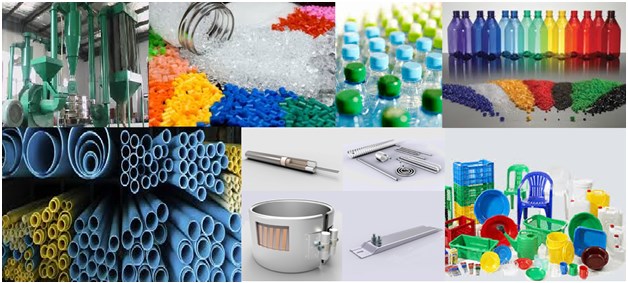- Home
- About
- Products
- Contact Temperature Sensors
- Cables & Wires
- Mineral Insulated Cables
- Nickel & Thermocouple Alloy
- Industrial Heaters
- Heating Cables and Mats
- Non Contact Temperature Sensors
- Industrial and R&D Furnaces
- Temperature Calibrators
-
Circulating Chiller
- Services
-
Special Products
- Thermal Profiling System
- Industries
- Resources
- Contact Us
- Shop
Less Known Uses Of Heater In Plastic Industry
In the last few decades, the Plastic industry has grown to the status of a leading sector in the country with a sizable base. The material is gaining notable importance in different spheres of activity like transport, aerospace, electronics and transportation. and the per capita consumption is increasing at a fast pace. Continuous advancements and developments in polymer technology, processing machineries, expertise, and cost effective manufacturing is fast replacing the typical materials in different segments with plastics. To make Plastic to the top Industrial heaters have played the substantial role.Industrial heaters helps in the processing of plastic by softening polymers in order to shape it into the desired form and inevitably into the products usually used. Hence, selecting the right equipment can aid the goal of higher productivity and greater yields.
Role Of Heaters in Plastic Industry:
Band heaters, tubular heaters and strip heaters are commonly used in the plastics industry. Steel screw plug and flange heaters are typically used for lubricant oils, heavy and light oils, waxes as well as mildly corrosive liquids and low flow gas heating (such as butane, propane or natural gas). Bag forming machines use cartridge heaters to help seal plastic bags and require controlling so as to protect the thin layers of plastic from melting.The use of thermocouples and precise digital controllers are also used to maintain target temperatures for each application. Some manufacturers use cartridge heaters that are inserted into steel or aluminum molds that heat up large surface areas. Aluminum or steel are excellent alloys as they distribute heat at a much quicker rate than other materials. They are also fairly inexpensive and can have holes pierced to hold thermocouples (type J or K) that would maintain the operating temperature that is required.

Now let’s have look to processes where Heaters are involved:
-
Blow Moulding ( BrE moulding ):
Blow molding is used to form hollow plastic parts. It is a manufacturing process generally used for forming glass bottles.There are three main types of blow molding: extrusion blow molding, injection blow molding, and injection stretch blow molding. Tempsens supplies and distributes heaters, sensor and temperature control solutions that provide long life for a wide variety of blow molding applications. -
Extrusion:
Plastics extrusion is process in which raw plastic is melted and formed into a continuous profile. Extrusion produces items such as pipe/tubing, weatherstripping, fencing, deck railings, window frames, plastic films and sheeting, thermoplastic coatings, and wire insulation.
This process starts by feeding plastic material (pellets, granules, flakes or powders) from a hopper into the barrel of the extruder. The material is gradually melted by the mechanical energy generated by turning screws and by heaters arranged along the barrel. The molten polymer is then forced into a die, which shapes the polymer into a shape that hardens during cooling.
Reliability, accuracy and high performance are some of the factors contributing to the optimal extrusion process and these features can be readily found in the recommended industrial heaters. In addition to controlling, history documentation have also become a necessity in various OEM or end user applications, to comply with various policies. Tempsens offers custom heater, sensor and control solutions that provide fast thermal response, consistent temperature accuracy with long life for a wide variety of extrusion applications. -
Injection Moulding:
Injection Moulding refers to shaping of rubber or plastic articles by injecting heated material into a mould. This process is the most common for making various products in the plastic industry. It makes use of different heaters and their control equipment for various applications. Injection mold machines use either nozzle heaters or cartridge heaters to help break the polymers into final products. Thermocouples and precise digital controllers are also used to maintain reference temperatures. Heaters are inserted into steel or aluminum molds that distribute heat very quickly to large surface areas. Barrel heaters are ideal for situations that require higher temperatures and tighter tolerances. Tempsens designs, engineers and supplies heater, sensor and control solutions for injection molding applications. -
Thermoforming:
Thermoforming is the process of heating a thermoplastic material and shaping it in a mould. Heaters required for Thermoforming should be robust radiant heater, temperature sensor and control solutions. To meet the demanding thermoforming applications such as vacuum forming, pressure assist forming, drape and press forming.
Selecting the right heater for particular application can aid the goal of higher productivity and greater yields. Tempsens offer’s high quality heaters and Temperature Sensors at very competitive price. Refer to www.tempsens.com for more detail.


